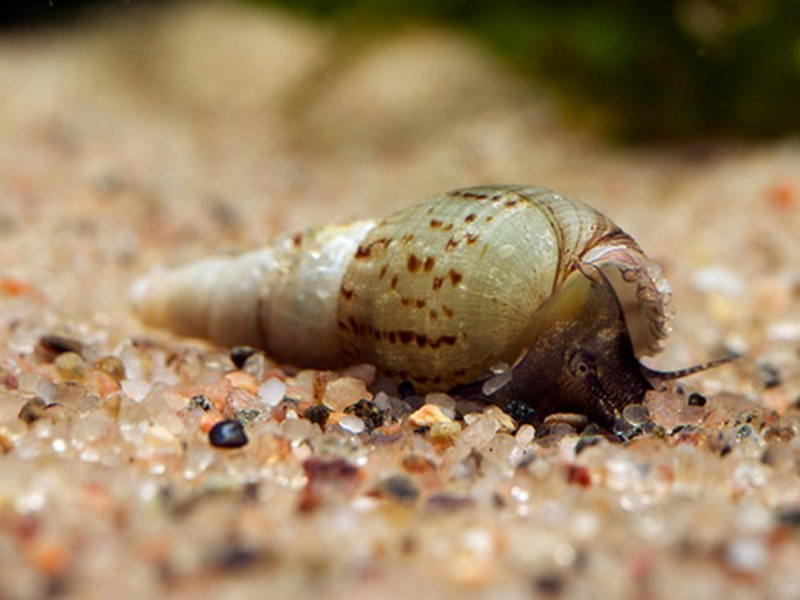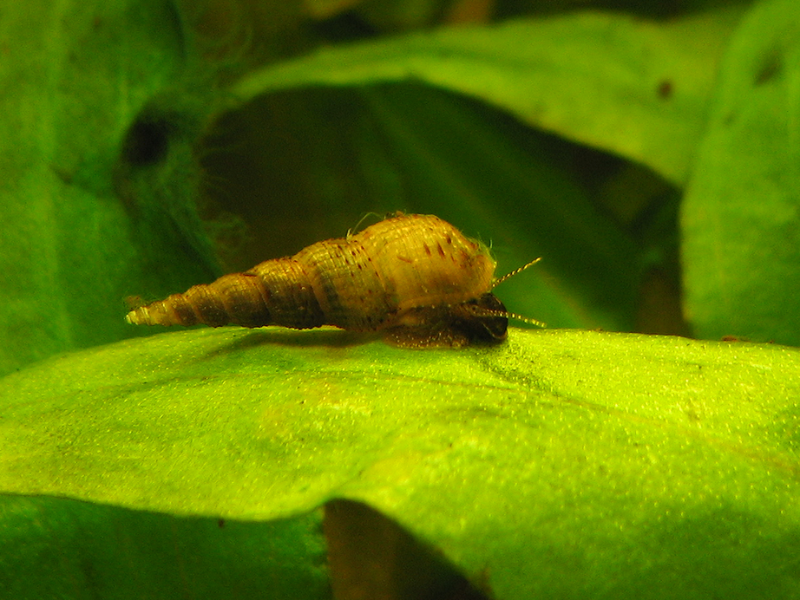Melanoides tuberculata
Malaysian Trumpet Snail

Scientific Classification
Quick Stats
Aquarium Building Information
About This Species
Basic Description
Malaysian Trumpet Snails are burrowing snails that help keep aquarium substrate clean and aerated, making them a popular choice for freshwater aquarists. These hardy invertebrates are excellent for beginners due to their adaptability and simple care requirements. Primarily active at night, they spend their days buried within the substrate, emerging in the dark to forage for food. This burrowing behavior is highly beneficial for a planted tank, as it helps to stir the substrate and prevent the buildup of harmful anaerobic pockets around plant roots.
As natural scavengers, they have a veracious appetite for detritus, leftover fish food, and nuisance algae, making them a fantastic addition to an aquarium's cleanup crew. They are peaceful and slow-moving, posing no threat to fish, shrimp, or healthy plants. While they are a valuable asset to an aquarium, it is important to note that they are prolific breeders. Their population size is directly related to the amount of available food; therefore, a sudden population boom can be a helpful indicator that an aquarist may be overfeeding their tank. They coexist peacefully in groups and are a functional and interesting addition to most community aquariums.
Detailed Description
The Malaysian Trumpet Snail, native to freshwater biotopes across Africa and Asia, is a highly beneficial and often misunderstood gastropod in the aquarium hobby. In its natural habitat, it thrives in slow-moving rivers and ponds with soft bottoms, a preference that translates directly to its behavior in a captive environment. Its most notable characteristic is its constant burrowing through the substrate. This activity is crucial for maintaining a healthy aquarium ecosystem, as it aerates the substrate, preventing the formation of toxic anaerobic zones that can harm plant roots and release harmful gases. This makes them particularly valuable in planted aquariums with deep sand or fine gravel beds.
These snails are primarily nocturnal, remaining hidden during the day and emerging at night to search for food. An unusual mass migration to the upper levels of the tank or the water's surface during the daytime can be a critical sign of poor water quality, low oxygen levels, or other stressors within the aquarium, serving as a 'canary in the coal mine' for observant aquarists. As detritivores, their diet consists mainly of decaying organic matter, biofilm, algae, and any uneaten food that settles on the bottom. In a very clean tank, their diet can be supplemented with algae wafers, sinking pellets, or blanched vegetables to ensure they receive adequate nutrition.
Their hardiness allows them to adapt to a wide range of freshwater conditions. They are peaceful and can be housed with most community fish and invertebrates. However, their slow nature and small size make them vulnerable to predation by specialized snail-eaters like loaches, puffers, and even other predatory snails. While their ability to reproduce quickly is often seen as a drawback, it is directly linked to nutrient availability. By managing feeding schedules and maintaining tank cleanliness, an aquarist can effectively control their population. For many, this snail is not a pest, but an integral part of a balanced, self-sustaining aquarium environment.
Scientific Description
Melanoides tuberculata is a species of freshwater gastropod mollusk belonging to the family Thiaridae. Its morphology is characterized by a dextrally-coiled, elongated, and conical (fusiform) shell, which typically features a pointed apex. A key anatomical feature is the operculum, a small chitinous or calcareous plate that the snail uses to seal the aperture of its shell for protection against desiccation and predation. Native to regions of Africa and Asia, its remarkable adaptability has led to its establishment as an invasive species in numerous subtropical and tropical areas worldwide. Its high tolerance for a wide spectrum of water hardness, pH, and even slight salinity contributes to its ecological success.
Physiologically, M. tuberculata exhibits a low metabolic rate and very low oxygen consumption. This allows it to thrive in its preferred benthic zone, often buried deep within the substrate where oxygen levels may be lower. Its ecological role is primarily that of a detritivore and primary consumer. It actively participates in nutrient cycling by consuming detritus, periphyton, and biofilm, breaking down complex organic matter into simpler forms. Its burrowing activity, a form of bioturbation, significantly alters the physical and chemical properties of the substrate, increasing aeration and preventing the formation of anoxic zones.
Reproduction in Melanoides tuberculata is predominantly achieved through facultative parthenogenesis, where females can produce offspring without fertilization. The species is ovoviviparous, meaning the embryos develop within eggs that are retained inside the mother's body until they are ready to hatch, resulting in the birth of live, free-swimming young. This reproductive strategy, combined with its environmental hardiness, is the primary driver behind its ability to establish dense populations rapidly. Its widespread distribution and stable population have resulted in a 'Least Concern' status on the IUCN Red List.
Breeding Description
Breeding Malaysian Trumpet Snails is considered exceptionally easy, and in most aquariums, it will occur naturally without any targeted intervention. The primary challenge for an aquarist is not inducing breeding, but rather managing the resulting population. These snails have a remarkable reproductive strategy that sets them apart from many other common aquarium snails.
They are primarily parthenogenetic, which means females can reproduce asexually without mating. A single snail can therefore establish a thriving colony on its own. Furthermore, they are ovoviviparous, giving birth to live, fully formed young instead of laying eggs. These miniature snails emerge from the mother's brood pouch as perfect replicas of the adults. Consequently, concepts like male-to-female ratios and sexing are not applicable for breeding purposes, as there are no discernible external differences between sexes, and one individual is all that is required.
There are no specific triggers needed to initiate reproduction. The breeding rate is almost entirely dependent on environmental conditions, with the single most important factor being food availability. In an aquarium with an abundance of leftover food, decaying plant matter, and algae, the snails will reproduce continuously and rapidly. Stable, warm water also supports consistent breeding. To encourage a larger population, for instance to supply a food source for other animals, one would simply need to provide a surplus of food in a dedicated tank.
The newborn snails require no specialized care. Upon birth, they are immediately independent and will instinctively burrow into the substrate to begin foraging for the same food sources as the adults, such as biofilm and fine detritus. To control the population in a display tank, the most effective method is to reduce feeding and increase tank maintenance to limit the available food. Manual removal is also a direct way to manage their numbers.
Generate Printable Card
Create a printable card for this creature to display in your store or aquarium. The card includes a QR code for quick access to more information.
